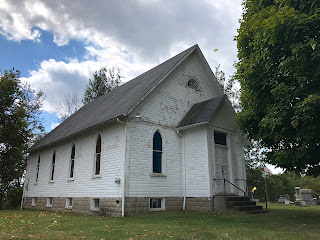Travels Outside the Keystone State. This site is an overflow to the Snow and Jaggers blog, which limits its shadowy explorations to Pennsylvania. For the main site, go to: snowandjaggers.blogspot.com
Wednesday, October 14, 2020
A View From the Top of the Adena Mound, Moundsville, West Virginia
Wednesday, October 7, 2020
Meditations on the Northern Panhandle
Monday, October 5, 2020
The Mexico of Pittsburgh
Thursday, October 1, 2020
Cooper's Rock, Barely West Virginia
Wildly Eccentric Marshall County, West Virginia
When I think about the Northern Panhandle of West Virginia, at best I call to mind scenes like this: hilly, woodsy, bucolic, and scenic if not exactly beautiful. At worst, I think of places like Chester, and Newell, and Weirton, all with their industrial decay and impoverished populations rolling around in 30-year old cars of American manufacture. This shot was taken from the churchyard of Allen Grove Presbyterian Church. I'd come here in part to see if it felt like "The South" and in part to scope out its tourist potential.
Allen Grove Church is situated in as lovely a spot as any church I know. It sits atop a tall green hill and presides over the surrounding countryside with a benign sort of air. This, too, is the kind of thing you would expect throughout West Virginia, even the Northern Panhandle--which I think is easily the least beautiful part of the state.
How the elderly folks get in and out of the church or attend funerals in the churchyard is beyond me. The grassy parking lot is all the way down near the bottom of the hill, and this place is all stair steps and headstones.
Pretty...and expected. It's a conventionally serene and pleasant scene that is found throughout America and especially in the East and South, a little white church on a hill.
What you might not expect in the Northern Panhandle of West Virginia is an enormous Hindu temple on a rural backroad. New Vrindaban is a large center for the Hare Krishnas--hidden deep among the hollers and forests and farms.
In fact, while driving on the rural road that runs past the temple, I had to stop and wait as two peacocks sauntered lazily across my path.
These are not signs you'd expect to see in the meadows and woods of early autumn. "New Vrindaban," "Palace of God," "Krishna Temple." I didn't have time to stop at the visitor's center, but this place is said to have an excellent, all-vegetarian restaurant and a lot of visitors from around the world.
Just down the hill and on the same road from this Hindu mission station to America, inhabited by missionaries from India, you've got this culturally-insensitive sign about a frontiersman who killed a lot of "Indians." This is more what you'd expect to find around these parts--where nearly half the houses have Trump signs and Trump flags out front.
It's an older cemetery but not ancient.
I'm not sure what this is about, but this little statue, waving Old Glory, was stationed at the entrance to the cemetery.
I'd come to the Moundsville area because it looked like it was home to a lot of exceptionally interesting stuff. First, you've got the largest and oldest burial mound in the country--foreground. Then you've got the old West Virginia Penitentiary--background. They face each other across the street, and both are open for tours.
Just for perspective, the tree growing on the side of the mound is a really big one.
The mound is incredibly tall for having been built entirely by hand.
The prison was decommissioned in 1995. Squeezing three prisoners into a 5' by 7' cell was finally deemed cruel and unusual. But this place is immense. My little cell phone couldn't begin to capture the vastness of it. This place is often visited by people interested in the paranormal. Speaking of which...






































